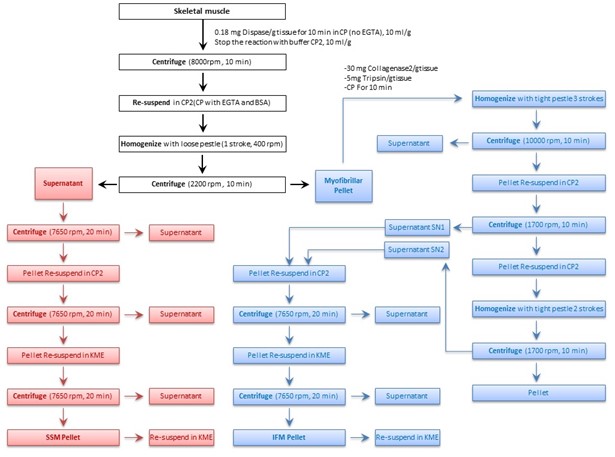Lai 2014 Abstract2 MiP2014
| Bioenergetic differences between permeabilized red and white fibers of a non-obese model of type II diabetes. |
Link:
Mitochondr Physiol Network 19.13 - MiP2014
Lai N, Kummitha C, Cabras S, Martis A, Hoppel CL (2014)
Event: MiP2014
The cause and effect relationship between mitochondrial dysfunction and insulin resistance (IR) is still under debate. It appears that lipid accumulation is the principal cause of IR, while the mechanisms leading to fat accumulation in skeletal muscle are not clear yet [4]. The reduced mitochondrial content, β-oxidation impairment or fat overload could contribute to the lipid imbalance in the obese population [1,2,4]. Furthermore, evidence has been provided for metabolic alterations in the skeletal muscle of insulin resistant non-obese patients. In particular, in vivo ATP synthesis in the skeletal muscle of young, lean, insulin resistant offspring of type 2 diabetes mellitus (T2DM) patients was 30% lower than that in control subjects [5]. Both T2DM and physical inactivity cause functional adaptations in skeletal muscle, in which IR is reflected in higher ratios of glycolytic to oxidative capacities [7]. Thus, a study on fructose-induced insulin resistant rats revealed differences in energy metabolism between oxidative and glycolytic fibers; mitochondrial function is preserved in oxidative fibers (e.g. Type I) whereas β-oxidation is impaired in glycolytic fibers (e.g. Type II) [8].
We used a spontaneous non-obese model of T2DM, the Goto Kakizaki (GK) rat, to study the relationship between IR and mitochondrial bioenergetics. Age-matched (18 weeks) Wistar (W) rats were used as control. We investigated skeletal muscle mitochondrial bioenergetics using permeabilized fibers of soleus and white gastrocnemius muscle. The permeabilization and respirometric measurements of the fiber were performed on fresh muscle samples according to the previously developed protocol [3]. Mitochondria content was determined by citrate synthase (CS) and succinate dehydrogenase (SDH) activities [6].
Respiration of soleus muscle fibers was similar in both W and GK rats for Complex I- and Complex II-linked substrates (Fig. 1). In contrast, respiration of white gastrocnemius fibers was lower in GK rats than in W rats, in the presence of Complex II substrate (Succinate, S). In both fiber types respiration in the presence of Complex IV substrate was lower in GK rats than in W rats. In soleus muscle, CS and SDH activities of GK rats (CS: 42.5±3.6, SDH 3.5±0.4 mU∙mg-1) tended to be lower than in W rats (CS: 46.3±1.9, SDH 4.3±0.4 mU∙mg-1, P<0.1). Similarly, in white gastrocnemius muscle, CS and SDH activities of GK rats (CS: 14.2±0.6, SDH 0.9±0.2 mU∙mg-1) were lower than those in W rats (CS: 17±1.9, SDH 1.3±0.3 mU∙mg-1, P<0.05).
Our results indicate that in absence of obesity, insulin resistance in skeletal muscle is related to a reduced mitochondrial content in both fibers types and to metabolic alterations only in type II fibers. Further studies are needed to investigate the relationship between IR and mitochondria biogenesis as well as the fibers contribution to substrate utilization during the progression of T2DM.
• O2k-Network Lab: US OH Cleveland Hoppel CL, US OH Cleveland Lai N, US VA Norfolk Lai N
Labels: MiParea: Respiration, mt-Biogenesis;mt-density, Exercise physiology;nutrition;life style Pathology: Diabetes, Obesity
Organism: Rat Tissue;cell: Skeletal muscle Preparation: Permeabilized cells
Regulation: Aerobic glycolysis, ATP production
Pathway: N, S, CIV
Event: C2, Poster MiP2014
Affiliation
1-Dep Biomed Engineering; 2-Dep Pediatrics; 3-Dep Pharmacology; 4-Center Mitochondrial Disease; 5-Dep Medicine, School Medicine; Case Western Reserve Univ Cleveland, Ohio, USA; 6-Dep Mechanical, Chem Material Engineering, Univ Cagliari, Sardinia, Italy. – [email protected]
Figure 1
References
- Archer SL (2013) Mitochondrial dynamics - Mitochondrial fission and fusion in human diseases. N Engl J Med 369: 2236-51.
- Holloway GP (2009) Mitochondrial function and dysfunction in exercise and insulin resistance. Appl Physiol Nutr Metab 34: 440-6.
- Lemieux H, Vazquez EJ, Fujioka H, Hoppel CL. (2010) Decrease in mitochondrial function in rat cardiac permeabilized fibers correlates with the aging phenotype. J Gerontol A Biol Sci Med Sci 65: 1157-64.
- Muoio DM and Neufer PD. (2012) Lipid-Induced mitochondrial stress and insulin action in muscle. Cell Metab 15: 595-605.
- Petersen KF, Dufour S, Befroy D, Garcia R and Shulman GI. (2004) Impaired Mitochondrial Activity in the Insulin-Resistant Offspring of Patients with Type 2 Diabetes. N Engl J Med 350: 664-70.
- Puchowicz MA, Varnes ME, Cohen BH, Friedman NR, Kerr DS, Hoppel CL (2004) Oxidative phosphorylation analysis: assessing the integrated functional activity of human skeletal muscle mitochondria-case studies. Mitochondrion 4: 377-85.
- Simoneau JA, Kelley DE (1997) Altered glycolytic and oxidative capacities of skeletal muscle contribute to insulin resistance in NIDDM. J Appl Physiol 83: 166-71.
- Warren BE, Lou PH, Lucchinetti E, Zhang L, Clanachan AS, Affolter A, Hersberger M, Zaugg M, Lemieux H. (2014) Early mitochondrial dysfunction in glycolytic muscle, but not oxidative muscle, of the fructose-fed insulin-resistant rat. Am J Physiol Endocrinol Metab. 306: 658-67.

